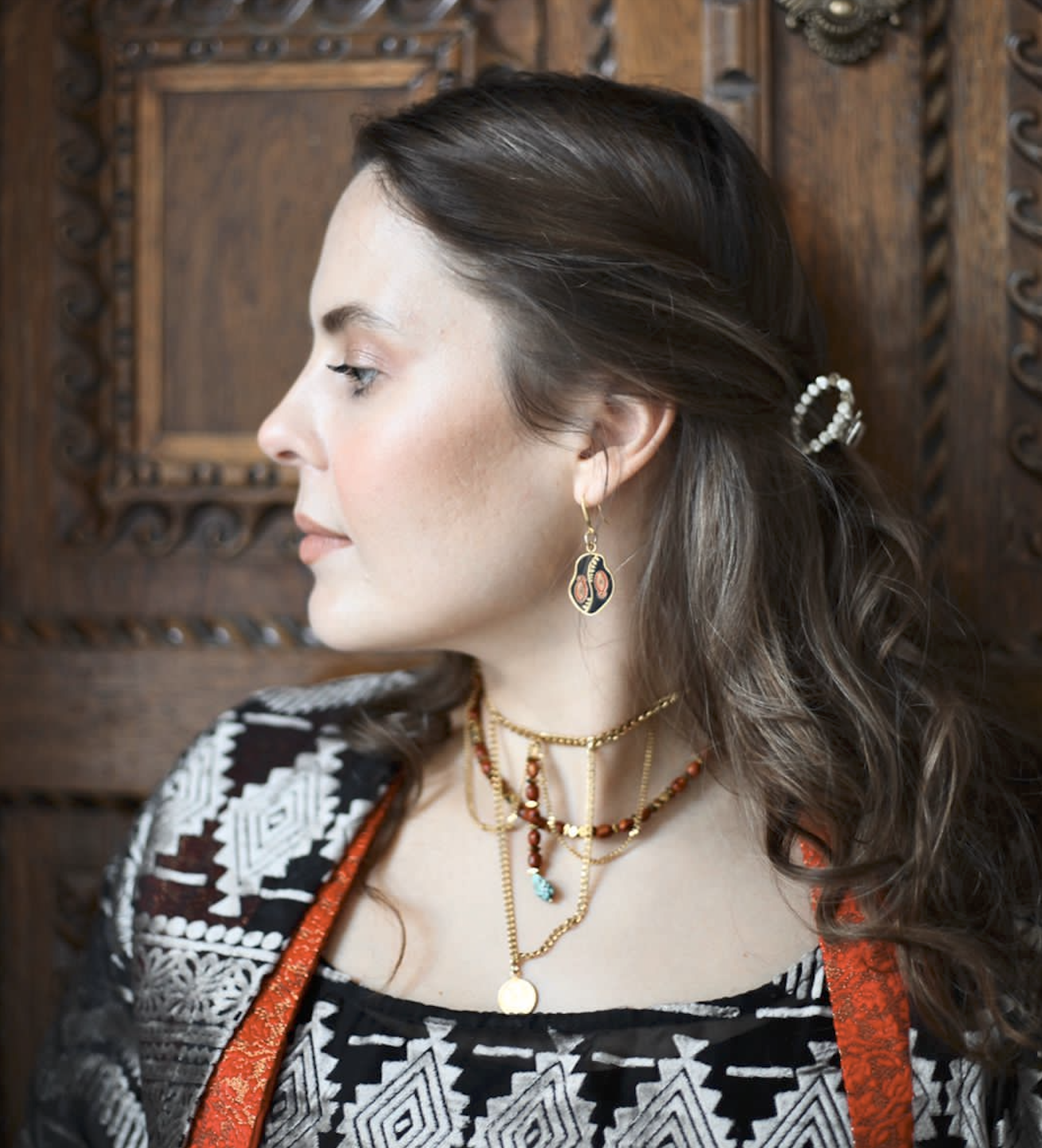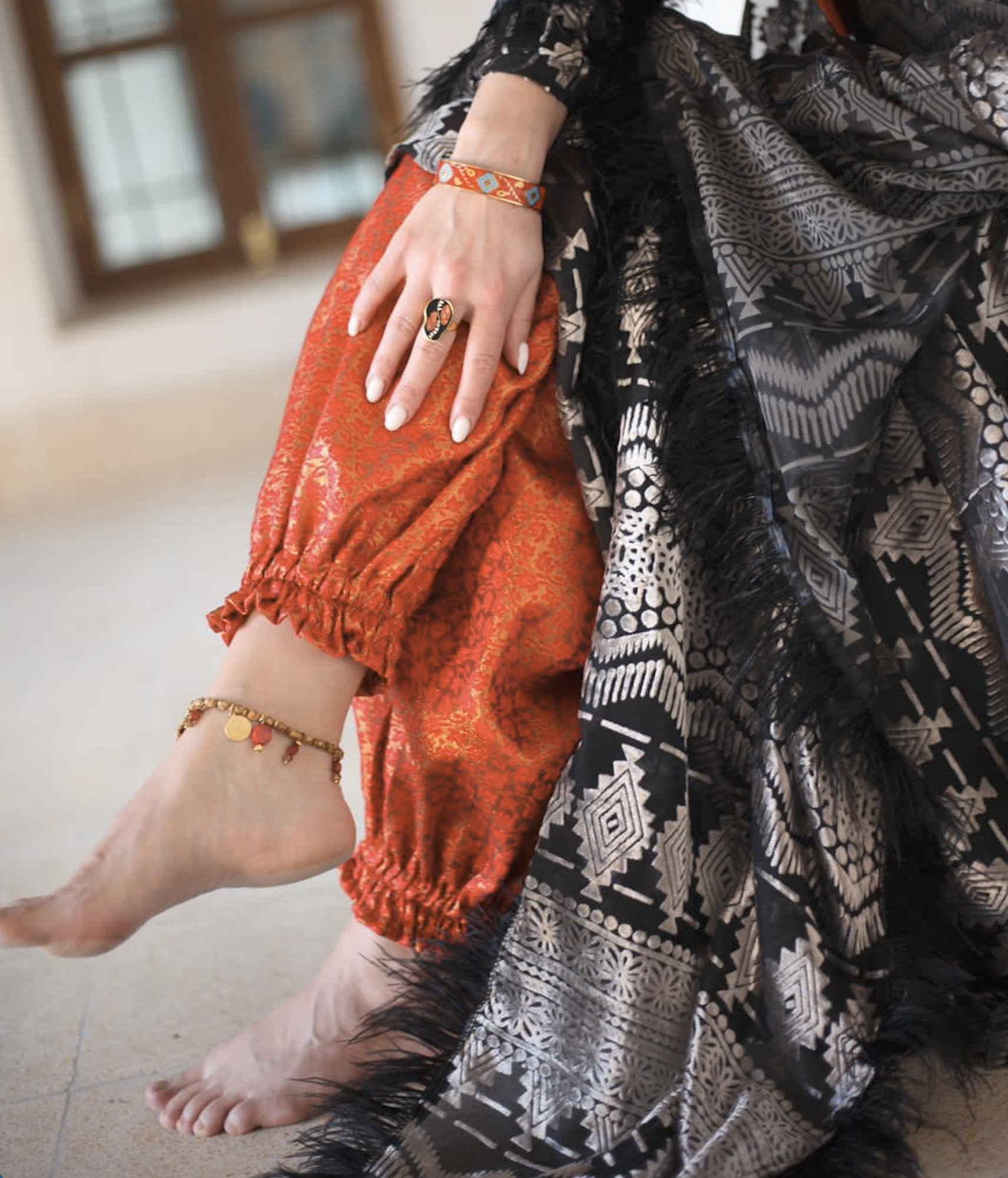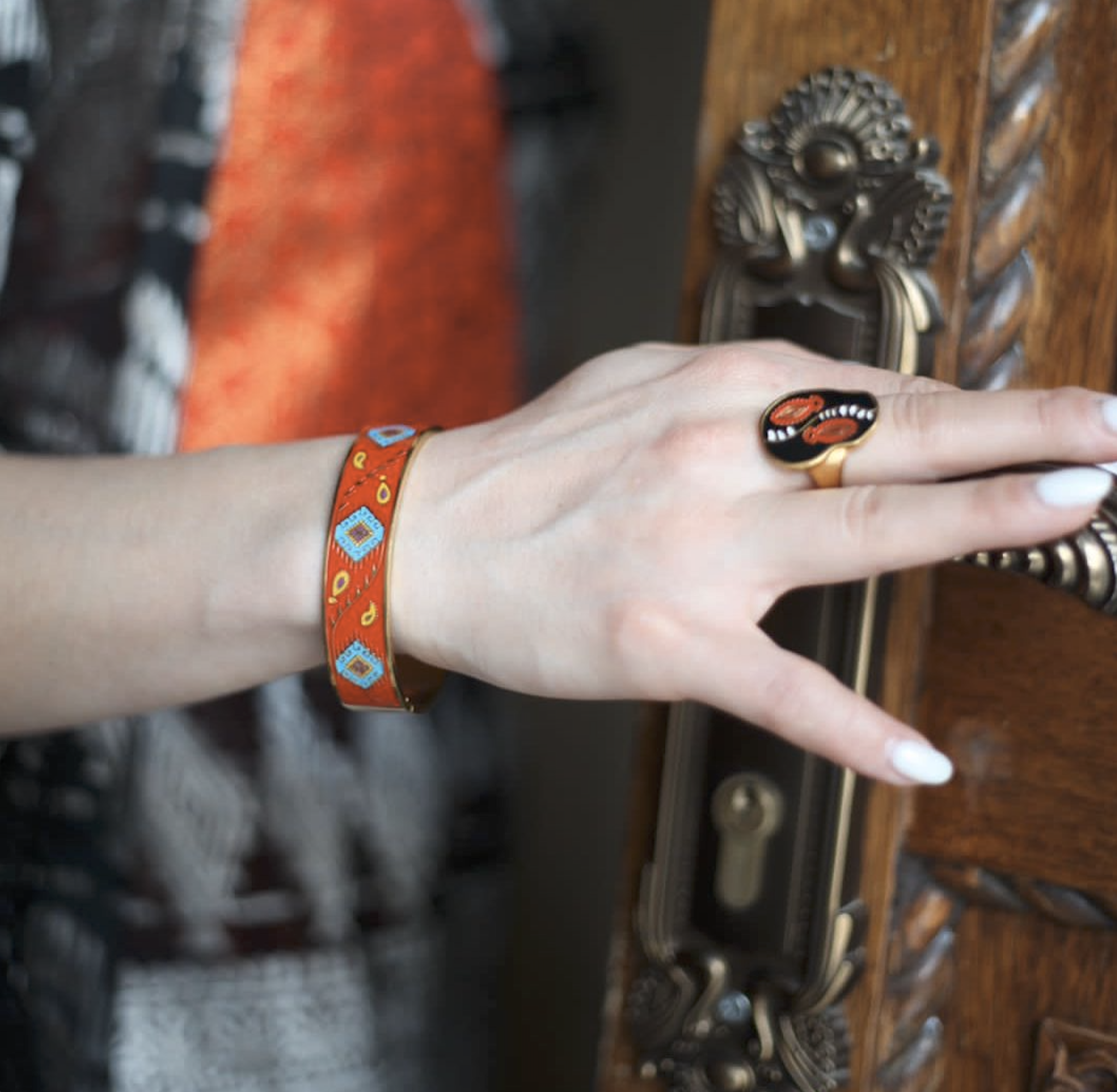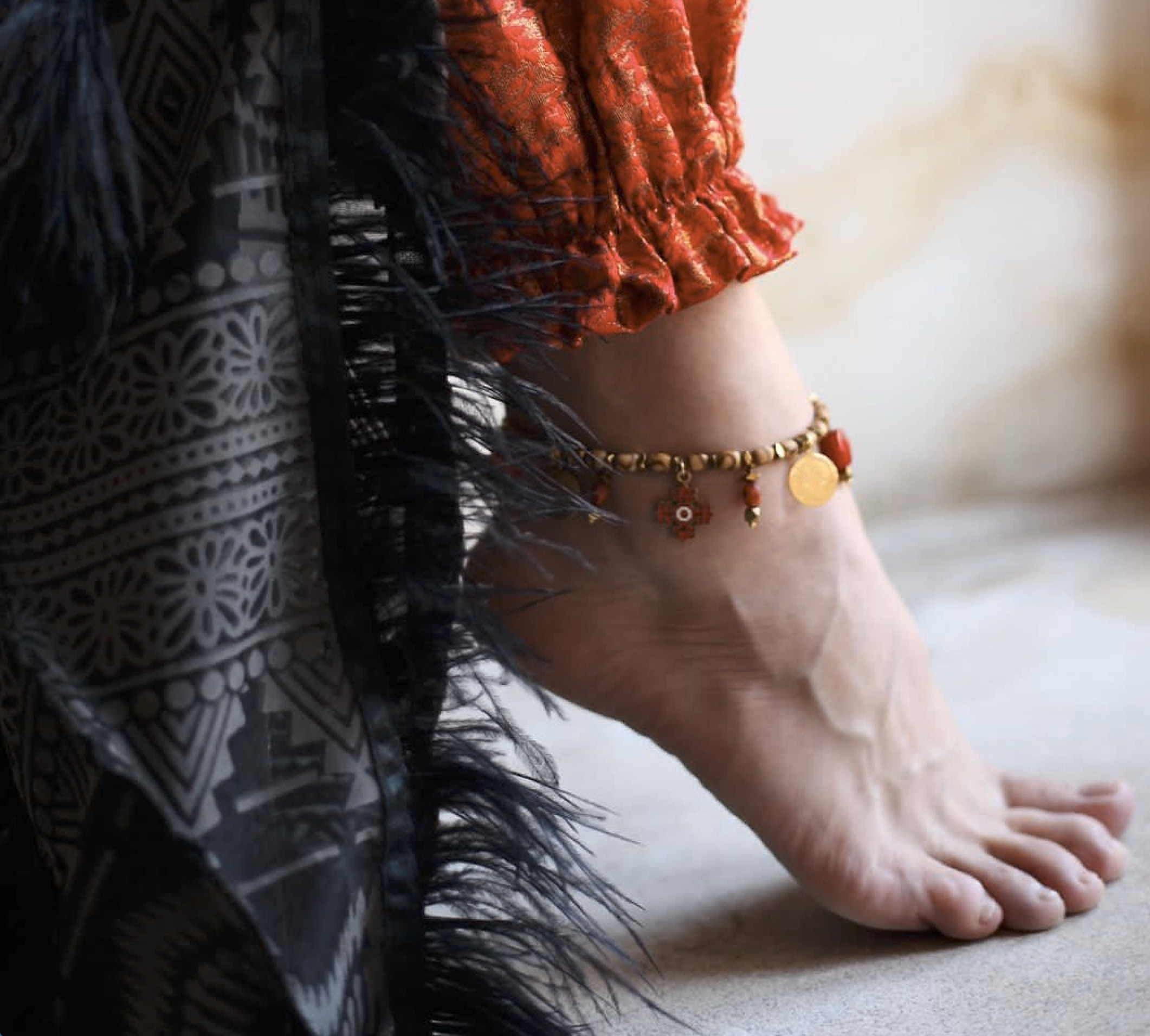Naskeh Omar, a 26-year-old artist who lives in Erbil, mixes different elements of nature, including plants and stones to create artistic masterpieces of the utmost accuracy and splendor. For manufacturing traditional jewelry and accessories like bracelets, earrings, necklaces, and rings, Naskeh relies on stone, terebinth grains, and exquisite inscriptions from the mythology of Kurdistan, Mesopotamia, and wild plants.
During her visit to Kurdistan Chronicle, the artist’s creativity immediately shone through. To dive deeper and try to understand her work and the source of her creativity, we visited her workshop, saw her latest designs, and spoke at length.

Starting with stones
Naskeh graduated from the Department of Business Administration and Political Science at the American University of Sulaymaniyah. After graduating, her parents expected that her to become an employee in a government department or in one of the many companies in Kurdistan, like many university graduates.
However, Naskeh had other ideas, turning to a profession that is far from her academic studies but close to her spirit. “Art has been in my blood ever since I was a child,” Naskeh says smiling. “Since my childhood, I felt that the stones, trees, planets, and stars, that surround me have spirits like human beings and that we can communicate with them. Stone has a language that we must master,” Naskeh went on to say as she showed us a beautiful transparent stone with red veins like blood. She puts the stone on top of her iPhone's flashlight, and it sparkles like a galaxy in the sky. I see a childish joy on her face. “This is a vibrant stone. It has a soul. These veins expand with time, just like crystal.”
She sees the amazement on my face and on that of my colleague, the skilled photographer Muhammad Dargalayi, but smiles confidently and, without worrying about our reactions, adds, "I was six years old when my father traveled. Like any father, he asked me what gift I would like him to bring home for me. I said without hesitation: I want stones, Dad."
Naskeh started her artistic career by engraving and drawing on stones. She showed me a beautiful collection of them that had matching colors, which she had collected in a basket. “At twenty, I had my first art show on International Women's Day, in cooperation with the French Consulate in Erbil. That was 2017. I started working on accessories and engraving them with enamel two years later when I was twenty-two years old.”

Nourishing creativity
Naskeh talks about her attempts to engage clients in creating their own designs. She opens several drawers that contain colored beads, raw rings, and colored stones, and indicates that she sometimes gives customers the freedom to choose the design they are thinking of, and says with confidence, “In this way, I want to make room for people to invest and develop their imagination. All human beings are artists in one way or another. They just need encouragement!”
Meanwhile, my colleague Muhammad is busy taking photos from the best angles of several of the delicate works that are displayed in beautiful order in the small workshop. The shots include beautifully designed bracelets on Naskeh’s wrists, earrings hanging from her ears, a necklace over her chest, and a handkerchief for the necklaces on her shoulders, whose patterns were inspired by a stone.
"People think this inscription is simply a cross, but it is actually of a traditional inscription that adorns the Kurdish scarf, which is known as hibri-hawri. I like to create a mix between Kurdish art and Red Sea coral," she says, as she juxtaposes the necklace stone with the beautiful red inscription on the edge of the scarf, which is called a Mosul scarf by some. Indeed, they are identical. How beautiful!

Philosophical underpinnings
With philosophical words scanted with love for Mother Nature, Naskeh sums up the nature of her work on natural elements. After she brings us water, she says, "Everything speaks in the nature that surrounds us. We can only understand its language if our soul is ready to listen. I would like to involve everything that bespeaks the nature of Kurdistan in my work. A grain of terebinth alongside a piece of stone with mythology and folk stories. The whole universe speaks. Even the heavenly bodies have voices.”
I tell her about the Greek philosopher Pythagoras, who claimed that the movement of celestial bodies in their spheres has special music, and that he could hear it. She nods her head with a smile.
I then turn back to her work. A beautiful bracelet inlaid with inscriptions that folk memory doesn’t forget catches my eye. The colors and patterns are wonderful. I ask her about their meanings, and she replies, "This is a pre-Islamic Kurdish inscription. A inscription of Jewish origin is still used in the manufacture of rugs, carpets, and pillows. I read about it in a book that I received from the Kurdish artist Rustam Aghala.”
“In the past, when a girl fell in love with a young man, she would give him a lock of her hair. The young man would take it to the rug makers, who mixed it with sheep's wool or goat hair and make this pattern on the rug. When the couple married, they hung the small rug on the wall in the house as a symbol of their love. I thought this is important because many girls have been killed and are being killed because of love. These rugs with wonderful patterns became an inspiration for me. I have taken the inscriptions as they are and put them on the bracelets.”
She goes on, "People are interested in yellow gold. This is, in my opinion, wrong. Pure gold is beautiful in appearance, but it lacks color. The demand for Ottoman liras (rashadiyat) for adornment is not a tradition inherent in Kurdistan society or culture. Nature is colors. If color elements are not incorporated into gold, its beauty will not appear. My work relies on golden stainless steel and especially enamel, which adds extra beauty and warmth to cold metals."

Marketing jewelry
Time passes quickly. I try to collect as much information about her work as possible. I ask her extemporaneous questions necessitated by the situation and by seeing more of her delicate and charming artefacts.
She uses her talent to create her own brand of jewelry and feels a responsibility when she sees Kurdish people do not have pieces that represent Kurdish culture and instead wear other culture’s designs such as Lira. “In our culture, Lira is so common that most women have it, but the design is originally from Turkey,” she says.
“As a jewelry designer and an artist, I want to create an artistic piece of jewelry that holds culture story. My aim is to make the design jewelry that represents our culture and spreads education among the new generation and other nations by telling them the story behind the designs. Beside culture design, I’m working on transferring my nature-inspired imagination to a unique piece of jewelry.”
I ask her about marketing and whether her products are in vogue, to which she replies, “At first, I found it difficult to market them, but then people grew more interested in them. Now my works are displayed in four outlets in Babel, Baghdad, Erbil, and Sulaymaniyah, and I can also sell globally.”
How familiar are you with the world of international jewelry and accessories? Another question I asked before the time we have dedicated for the interview expires. My colleague Mohamed continues taking pictures, while Naskeh continues to answer with love and patience. "I follow the world’s famous designs. The majority are without spirit because they do not originate from a true artistic imagination. The designs look similar, as if the designers are imitating one another,” she said.

Nature as a source of inspiration
“I’m inspired by creatures under the ocean, the art of nature, the shapes of plants, and of course Kurdish culture. I want to give the local folklore the value it deserves. I hope to work on the Kurdish legend of Shahmaran and be inspired by patterns and designs from Kurdish love stories. I feel a responsibility towards my country and my people. Therefore, I can say that these designs are close to my heart and soul. I am also thinking of drawing inspiration from some verses of poetry by the great Kurdish poets and Kurdistan nature-inspired designs with its stones, plants, and insects. I even look at the veins of my hands sometimes and see in them exquisite designs and beautiful art. In the depths of the oceans there are beautiful sea creatures that are suitable for becoming engravings on bracelets or rings. Some plants, with their leaves and flowers, become rich ideas for the design of earrings.”
In Naskeh‘s eyes, I see the passion of a professional artist and the delight of those fascinated by their work. Here, I remember Michelangelo, who is said to have shouted at the statue of the Prophet Moses, “Speak, O stone!”
Naskeh too says that she listens to the stones and believes they have language, as do silent creatures such as plants and trees.
On the way back to the magazine's office in the English Village, I looked out the window of the car, which the photographer Muhammed still driving. As I looked at the beautiful residential houses on both sides of the road, it hit me that these were built of stones. I did not talk. Rather, I started listening to the stones speaking.